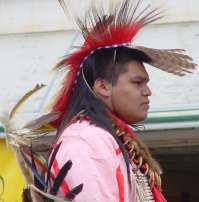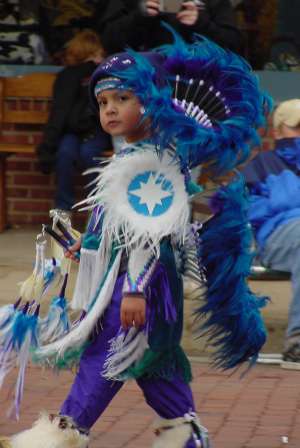|
Tribes |
||
|
© 1996, 1997,1998, 1999, 2000 Cyber Lodge Internet Services. All rights reserved. Any copying, redistribution or retransmission of any of the contents of this service without the express written consent of Cyber Lodge Internet Services is expressly prohibited.
|
The Five Tribes of The Plains Arapaho - Comanche - Prairie Apache - Kiowa - Cheyenne Arapaho The Arapaho originally lived near Lake Superior and were farmers who raised large amounts of corn. They eventually drifted to the great plains, where they became monads, and followed the great buffalo herds. During the migration, the Arapaho were generally allied with the Cheyenne. Eventually, the Arapaho split into two separate tribes, northern Arapaho and Southern Arapaho. From earliest documentation to the time the Arapaho were put on reservations ,they were fighting with the Shoshoni, Ute, Navaho, and Pawnee tribes. After 1840, the Arapaho were at peace with all other Plains Tribes. The Arapaho were often allied with Comanche and Kiowa, not to mention the ever-present Cheyenne. In 1867, the Arapaho met U.S. government commissioners at the Medicine River, along with four other tribes; the Cheyenne, Kiowa, Comanche and Apache. Chief Little Raven, the chief of the tribe and a great orator, made a self-prepared and impassioned speech. Another distinguished Arapaho at the conference was Mrs. Virginia Adams, the daughter of an American trapper and Arapaho woman. Mrs. Adams was a great interpreter who knew many Indian languages, as well as English.
Comanche The Comanche originally lived in the Rocky Mountains, where they were primarily hunters and ate fish and large game. Their early explorations to the south of the mountains caused them to come into contact with Spanish settlers and their horses. Horses soon became a very important part of the Comanche lifestyle, and bands of Comanche would travel as far as Chihuahua, Mexico to steal or trade them. One of the Comanche rivals were the Caddoan people in New Mexico. The Comanche and Caddoan fought repeatedly until 1746, when the French succeeded in making a peace alliance between them. After that, the comanche and Caddoan were generally war allies. As the Comanche moved further into Oklahoma, they began fighting the Kiowa. In 1790, the two tribes held a council, and made a peace agreement that has never been broken by either tribe since then. The Comanche joined thousands of other Indians, government commissioners, army officers, press representatives and interpreters. Comanche Chief Ten Bears gave an orations that stands out as one of the finest delivered by an Indian in the history of America. In the Medicine Lodge Peace Treaty, the Comanche were granted 2,968,893 acres of land south of the Washita River in Oklahoma. The new conditions of tribal life and the disappearance of the buffalo caused the Comanche to lash out against the white settlers and take a rebellious attitude against the government. The treaty of Medicine Lodge did not solve the Indian problem, because the presence of soldiers and white settlers on the reservation, who were ready for action at the slightest sign of trouble, made the Indians wary and more hostile than ever before.
Prairie Apache (Kiowa-Apache) The Prairie Apache, also known as the Kiowa-Apache, were associated with the Kiowa before the Kiowa left the Rocky Mountains. The Prairie Apache were also known as Catacka, Kataka, and Quataquois by explorers such as Lewis and Clark, and La Harpe. Since 1837, when the Prairie Apache and Kiowa signed their first treaty with the United States at Fort Gibson, the two tribes have had a common history. The Prairie Apache were also associated with the Cheyenne for a period of time, but reunited with the Kiowa at the Medicine Lodge Peace Treaty in 1867. The Prairie Apache settled in a reservation with the Kiowa and Comanche tribes. The principal Prairie Apache chief, Pacer, was known as a peace maker on the reservation until his death in 1875. The tribe settled peaceably on the reservation and were highly commended by the American government for their industry and their ability to make their own living. Kiowa The Kiowa, tribe, said to be the bravest and most courageous, yet also the most warlike of the Plains tribes, originally migrated from the Rocky Mountains. During the time of Indian raids, the Kiowa were said to have killed more white men than any other tribe. According to legend, the Kiowa started out in the northern Rocky Mountains, near Yellowstone Park in Montana. They split after two great chiefs had a dispute that grew into an angry quarrel. Most of the Kiowa traveled southward, becoming the Kiowa we know today. The Kiowa’s first alliance after migrating was with the Crow tribe. They settled near the Crow, and it was there that they first came into possession of horses. The Kiowa later drifted to the Black Hills, and from there to the Arkansas River after fighting with the Cheyenne and Dakota in the Black Hills. In 1790, the Kiowa made peace with the Comanche, a tribe they had been fighting for many years. They also made permanent peace with the Cheyenne and Arapaho in 1840. One of the Kiowa’s most constant allies and companions was the Prairie Apache or Kiowa-Apache. The Medicine Lodge Peace Treaty on 1867 gave the Kiowa and Comanche a reservation lying west from the 98th meridian between the Wachita River on the north, and the Red River and its North Fork on the south. The Prairie Apache, which were considered a federated part of the Kiowa, were also included in the reservation. Ten Kiowa leaders signed the treaty, including the Chief Satanta, who was considered the most talented Indian orator present. After the Kiowa were forced to make their home on the great reservation, they became known as the most defiant of the Plains tribes. They continued to raid white villages, stealing horses and killing whites. Their leader, Satanta, was arrested several times, and in 1874, committed suicide while in prison. Cheyenne The Cheyenne, originally from the area that is now Minnesota, were once great agriculturists and pottery makers. They lived in permanent villages, before traveling south with the Arapaho tribes to become nomadic buffalo hunters. When the Cheyenne speak of becoming nomads, the day they "lost the corn", meaning they gave up farming. The Cheyenne are a characteristically proud, contentious and brave people. Their women uphold high moral values. The Cheyenne migration to the Plains was hurried along by the fact that they were constantly pursued by the hostile Sioux. The Cheyenne finally ended up along the Arkansas River, where they began a hostile feud with the Kiowa. The climax of this bitter warfare came in 1838 on Wolf Creek in northwestern Oklahoma. There were great losses on both sides of the battle. Two years later, the Cheyenne made peace with the Kiowa. In 1864, the Cheyenne suffered great tragedy at the hands of the American government. Although Cheyenne Chief Black Kettle and his followers had recently made a peaceful agreement with officer, their village was attacked and destroyed. Most of those slain were women and children. "Sand Creek Massacre" as this event was called was referred to as "the foulest and most unjustifiable crime in the annals of America (80)."
Editor’s Note: The information presented in this story was taken from the following source: Wright, Muriel H. A Guide to the Indian Tribes of Oklahoma. University of Oklahoma Press; Norton. 1951. |
|



